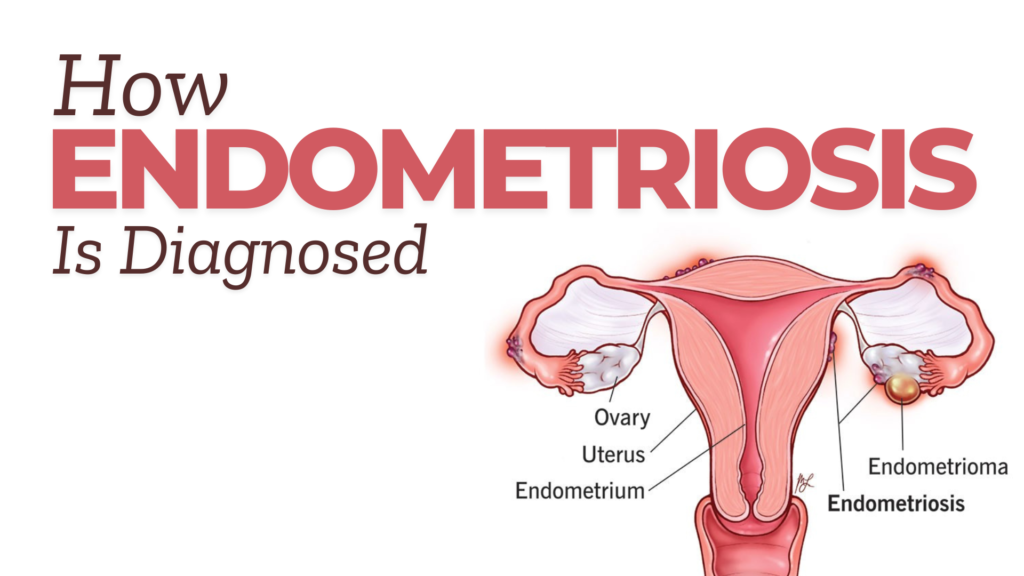
What is Endometriosis?
Endometriosis is a chronic, painful condition where tissue similar to the lining of the uterus (endometrium) grows outside the uterus. These abnormal growths, often found on the ovaries, fallopian tubes, and pelvic walls, can cause severe pain, inflammation, and even infertility.
Understanding how endometriosis is diagnosed is critical because early detection enables effective treatment. Women with endometriosis often face years of misdiagnosis due to overlapping symptoms with other conditions, such as irritable bowel syndrome (IBS) or pelvic inflammatory disease (PID).
How Endometriosis Is Diagnosed
Diagnosing endometriosis requires a systematic approach, combining medical history, physical exams, imaging tests, and sometimes surgery. Let’s explore how doctors determine the presence of this condition.
1. Symptom Assessment
Your doctor will start by asking about symptoms commonly associated with endometriosis:
- Severe menstrual cramps (dysmenorrhea)
- Chronic pelvic pain, even between periods
- Pain during intercourse or bowel movements
- Heavy menstrual bleeding or irregular periods
- Fatigue, bloating, or nausea
Tracking your symptoms in a journal can provide valuable insights and help pinpoint when how endometriosis is diagnosed becomes a priority.
2. Physical Examination
A pelvic exam is often the next step. During this examination, a doctor may feel for abnormalities, such as cysts or scar tissue around the uterus and ovaries. Although a pelvic exam cannot definitively confirm endometriosis, it provides important clues for further testing.
3. Imaging Tests
Advanced imaging technologies play a vital role in the diagnostic process:
- Ultrasound: Transvaginal and abdominal ultrasounds can detect ovarian cysts called endometriomas, a hallmark of endometriosis.
- MRI (Magnetic Resonance Imaging): MRI scans provide detailed images of the pelvic region, identifying deeper lesions and their extent.
While imaging alone cannot definitively diagnose endometriosis, it helps guide the next steps in the process of how endometriosis is diagnosed.
4. Hormonal Response Monitoring
Doctors sometimes prescribe hormonal medications to assess symptom response. Improvement in symptoms during hormone therapy may suggest endometriosis.
5. Laparoscopy: The Gold Standard
Laparoscopy is a minimally invasive surgical procedure that provides a definitive diagnosis. Through a small incision in the abdomen, a camera (laparoscope) is inserted to visualize endometrial implants.
- Biopsies of the abnormal tissue are often taken to confirm the diagnosis and rule out malignancies, such as what’s endometriosis cancer or other conditions.
- This step is crucial in understanding how endometriosis is diagnosed with precision.
Can Endometriosis Be Treated?
While endometriosis has no permanent cure, effective treatments are available to manage symptoms and improve quality of life.
1. Pain Management
- NSAIDs: Nonsteroidal anti-inflammatory drugs like ibuprofen help alleviate pain.
- Prescription medications: Stronger pain relievers may be necessary for severe cases.
2. Hormonal Therapy
Hormonal treatments can slow or stop the growth of endometrial tissue by suppressing the menstrual cycle. Common options include:
- Birth control pills
- Progestin therapy
- Gonadotropin-releasing hormone (GnRH) agonists
These therapies are particularly helpful in reducing the progression of endometriosis, which is critical after how endometriosis is diagnosed and confirmed.
3. Surgical Treatment
For women with severe endometriosis or infertility concerns, surgery may be the best option.
- Laparoscopic excision surgery: Removes endometrial implants while preserving fertility.
- Hysterectomy: In extreme cases, removing the uterus (and sometimes ovaries) may provide long-term relief.
Can Endometriosis Cause Infertility?
Yes, endometriosis is one of the leading causes of infertility, affecting 30-50% of women with the condition. This occurs due to:
- Scar tissue and adhesions blocking fallopian tubes.
- Inflammation altering the pelvic environment, preventing egg fertilization or implantation.
However, advancements in fertility treatments, including intrauterine insemination (IUI) and in-vitro fertilization (IVF), have significantly improved pregnancy outcomes for women diagnosed with endometriosis.
Can Endometriosis Go Away?
Endometriosis is a chronic condition, and while symptoms may improve during pregnancy or menopause, the disease itself rarely disappears without treatment. Early diagnosis and consistent medical care play a vital role in symptom management.
Can Endometriosis Turn Into Cancer?
Endometriosis is generally benign. However, in rare cases, it can lead to endometriosis-associated ovarian cancer (EAOC) or other malignancies. Women with prolonged or untreated endometriosis should undergo regular monitoring to mitigate risks.
How Much Endometrial Thickness Is Normal?
Endometrial thickness fluctuates during the menstrual cycle:
- Menstrual phase: 2-4mm
- Follicular phase: 5-7mm
- Luteal phase: 7-16mm
If endometrial thickness exceeds normal ranges, it may indicate hormonal imbalances or conditions such as endometriosis. Understanding these nuances is essential in both treatment and how endometriosis is diagnosed.
Conclusion
Understanding how endometriosis is diagnosed is the first step toward effective treatment and improved quality of life. From symptom assessment to advanced diagnostic techniques like laparoscopy, each step brings women closer to relief and clarity.
If you suspect you have endometriosis, don’t wait. Seek medical advice, explore treatment options, and remember—early intervention can make all the difference.
FAQs
What’s the best age to diagnose endometriosis?
Endometriosis is often diagnosed in women aged 25-40, but symptoms can start as early as adolescence. Seeking medical help early is key.
How does endometriosis impact mental health?
Chronic pain and infertility can lead to anxiety and depression. Psychological support, alongside medical treatment, is essential for overall well-being.
Is there a genetic link to endometriosis?
Yes, women with a family history of endometriosis are more likely to develop the condition.
Can lifestyle changes help manage endometriosis?
Yes, maintaining a healthy lifestyle, exercising regularly, and eating an anti-inflammatory diet can reduce symptoms.
How long does it take to diagnose endometriosis?
On average, it takes 7-10 years to diagnose endometriosis due to overlapping symptoms with other conditions.
Are there natural remedies for managing endometriosis?
Natural remedies, such as dietary changes and acupuncture, can complement medical treatments but should not replace them.

